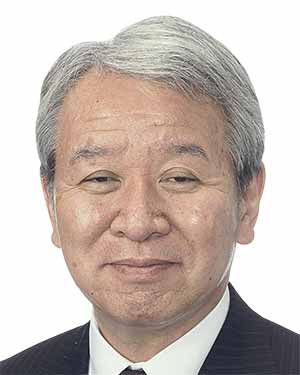12:06 JST, September 22, 2023
While tensions continue to deepen between the United States and China, one region in the world has been undergoing a transformation in its strategic environment since Russia launched its invasion of Ukraine in February 2022. That is inland Asia.
The Global South has been much talked about of late, but it’s not just countries in the “south” that the Western liberal camp, including Japan, should attach importance to — some are located in the Northern Hemisphere.
Inland Asia spans Mongolia, the five Central Asian countries of Kazakhstan, Uzbekistan, Tajikistan, Kyrgyzstan and Turkmenistan and the three Caucasian countries of Georgia, Azerbaijan and Armenia. All but Georgia are landlocked.
Their economic levels vary. Per capita gross domestic product amounts to more than $10,000 in oil-producing Kazakhstan and Turkmenistan but remains within the $1,000 range in poor countries such as Kyrgyzstan and Tajikistan. In political terms, democracy has been advancing in Georgia and Mongolia, but many countries in the region are still authoritarian.
All but Mongolia used to be part of the now-defunct Soviet Union. Even today, they are closely connected to Russia. Kyrgyzstan and Tajikistan, for instance, deploy about 1 million workers each to Russia to benefit from their remittances, which constitute more than 30% of their GDP.
The Russian invasion of Ukraine has had a great impact on inland Asia, but this does not imply that the diplomacy of inland Asian countries has changed drastically. In fact, Russia, along with China, remains so important a trading partner to most of them, they have no choice but to keep bilateral economic relations intact. Some observers have pointed out that, although no precise numerical data is available, breaches of the economic sanctions against Russia have continued unabated via Central Asian countries.
When the U.N. General Assembly adopted a resolution decrying the Russian invasion of Ukraine in March 2022, Georgia was the only inland Asian country that voted for it. All the other nations in the region either abstained or were absent.
Then how has inland Asia’s strategic environment changed so drastically?
First, inland Asian leaders began thinking that it would be better to reconsider relations with Russia. The same leaders became seriously worried, telling themselves, “Tomorrow, it may be us,” when Russian President Vladimir Putin justified the invasion of Ukraine by claiming that no independent nation called Ukraine had existed in the first place.
The fact that the Islamic Taliban militia returned to power in Afghanistan in the summer of 2021 is also related to the change in inland Asia’s strategic environment. Due to the increased fluidity of the Afghan situation, Central Asian goods are now least likely to be transported to the Indian Ocean via Afghanistan. Inland Asian countries are at an impasse, as they no longer can count on their northern distribution route via Russia — which has been impeded by the West’s economic sanctions against Moscow — or their southern supply network via Afghanistan. As a result, they now are asking themselves this: Is going through China the only way for inland Asia to be connected to the rest of the world?
China’s new approach
As the second aspect of the change in inland Asia’s strategic environment, I should refer to a change in China’s own interests in the region.
In 1996, China took the initiative in establishing the Shanghai Cooperation Organization with a view to further developing relationships with Russia and inland Asian countries. Nonetheless, up until the Russian invasion of Ukraine, China had concentrated on strengthening economic ties with SCO member countries, while approving of Russia’s political clout over the inland Asian region.
However, China took a new approach to the region in May this year, as if coinciding with the Group of Seven’s summit in Hiroshima. Specifically, Beijing hosted the China-Central Asian Summit in Xi’an, inviting the leaders of the five Central Asian countries. The Chinese move has been interpreted as heralding the beginning of its full-fledged drive to bring inland Asia within its political sphere of influence.
The United States, for its part, has awakened to the importance of inland Asia. U.S. Secretary of State Antony Blinken visited Kazakhstan in February this year to hold talks with his counterparts from the five Central Asian countries. Given that certain Central Asian leaders regard Washington’s role as an essential factor for the stabilization of Afghanistan, the United States and the five countries are likely to keep moving to enhance their relations based on their shared expectations.
Four months earlier, in October 2022, the European Union held its first summit with five Central Asian countries in Kazakhstan.
So, how about Japan?
Japan started paying attention to Central Asia much earlier than the West. In 2004, it inaugurated the Central Asia plus Japan Dialogue, with its ninth meeting taking place in Tokyo late last year.
Japan’s high-level exchanges with Mongolia date back decades. In the post-Cold War era, Japan continued to be a leading provider of support to inland Asia from the standpoint of international cooperation. It has emphasized human resources development, with some Kyrgyz and Tajik students completing graduate courses in Japan with Japanese scholarships and eventually assuming ministerial posts back home.
Japan needs new concept
That said Japan needs to make much more diplomatic effort to act as an intermediary between inland Asia and the rest of the world.
First, Japan should view the whole of inland Asia as a single diplomatic theater. As its coinage of the geographic concept of a “free and open Indo-Pacific” has led to the convergence of Southeast Asia, South Asia and sub-Saharan Africa, regions that had been dealt with separately in the past, it now should come up with a new concept of a “free and open inland Asia” and press ahead with a comprehensive strategy encompassing the region from Mongolia to Central Asia to the Caucasus.
Second, Japan should prioritize improving its support for Mongolia and Georgia, where democracy has been taking root, and Kyrgyzstan, which looks highly likely to be democratized. Once it is proven that democratization is feasible even in inland Asia, which now is home to many authoritarian regimes, this trend is expected to bolster the rise of democratization elsewhere in the world as well.
Third, Japan should enhance support for inland Asian countries that seek new ocean- or sea-bound transit routes as an alternative to those via China and Russia. Japan may be able to help install a “central corridor” linking Azerbaijan with the Black Sea via Georgia.
Japan should not give up its efforts to bring an end to the Taliban regime’s human rights abuses in Afghanistan, although it is less likely to be successful in this regard. Should Afghanistan transform itself into a “normal country” and be recognized by the rest of the world, it would be possible for a pathway to be established from Central Asia to the Indian Ocean through the landlocked country.
As for Mongolia, it is and will remain impossible for it to be connected to any ocean or sea via land without going through Russia or China. Japan should therefore help the inland country strengthen aviation-based connectivity.
The strategic environment surrounding inland Asian countries is harsh, as mentioned above. If U.S.-China and U.S.-Russia tensions continue to intensify, demanding that countries in the region choose either the Western liberal camp or the China-Russia camp would only put them in a difficult situation.

Akihiko Tanaka
Tanaka is president of the Japan International Cooperation Agency (JICA), a post he took up in April 2022 for the second time after his first stint in 2012-15. He served as president of the Tokyo-based National Graduate Institute for Policy Studies (GRIPS) from 2017 to March 2022. Previously, he was vice president of the University of Tokyo from 2009 to 2012.
The original article in Japanese appeared in the Sept. 17 issue of The Yomiuri Shimbun.
"Editorial & Columns" POPULAR ARTICLE
-

Violations of Subcontract Law: Major Automakers Must Eliminate Old Practices
-

Local Governments’ Tax Revenues: Devise Ways to Correct Imbalances in Tax Sources
-

5 Japanese Business Dinner Mistakes to Avoid — and What They Taught Me About Business in Japan
-

Heavy Rains in Asia: Support for Victims, Flood-Control Measures Urgently Needed
-

Rice Coupons: A Misguided Approach to Countering Rising Prices
JN ACCESS RANKING
-

Keidanren Chairman Yoshinobu Tsutsui Visits Kashiwazaki-Kariwa Nuclear Power Plant; Inspects New Emergency Safety System
-

Imports of Rare Earths from China Facing Delays, May Be Caused by Deterioration of Japan-China Relations
-

University of Tokyo Professor Discusses Japanese Economic Security in Interview Ahead of Forum
-

Japan Pulls out of Vietnam Nuclear Project, Complicating Hanoi’s Power Plans
-

Govt Aims to Expand NISA Program Lineup, Abolish Age Restriction

























